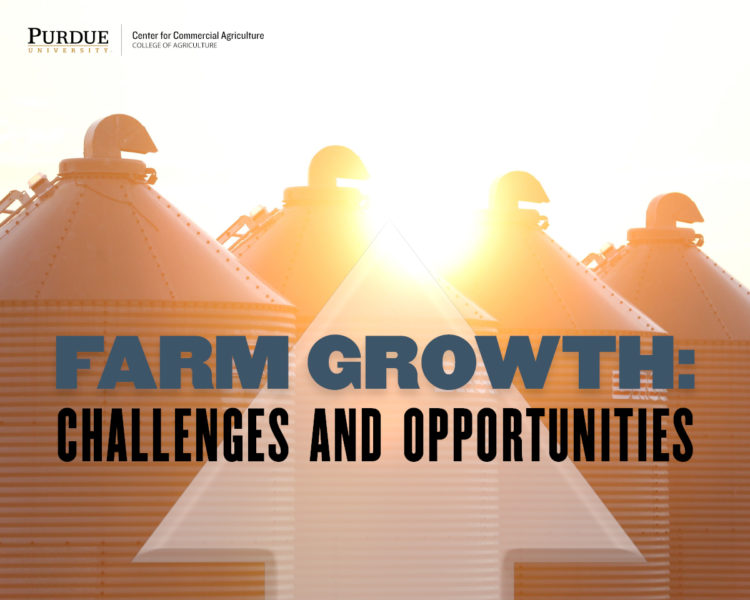December 12, 2017
What Strategic Issues Should Influence my Growth Options?
There are numerous motivations for farms to expand their businesses. Even in today’s environment of tight margins, many farms are exploring expansion options. When exploring these options, it is important to address key questions pertaining to the farm’s strategy. A previous article, discussed ten questions that should be addressed when examining challenges and opportunities associated with farm growth. This article focuses on the third question: what strategic issues should influence my growth options?
When evaluating growth options, it is important to conduct an internal and external analysis of your farm business. An internal analysis identifies key resources, capabilities, and competencies (Gray et al., 2004). An external analysis involves assessing the farm’s business environment, and assessing the farm’s opportunities and threats (Dobbins et al., 2004).
Internal Analysis
An internal analysis typically starts by identifying key resources. These resources may involve working capital, capital structure, machinery and equipment, land base, employee skills, and/or management talents. One of the ways to assess these key resources is to ask yourself whether your operation has unique resources that lead to a sustained competitive advantage (Langemeier, 2016). Identifying and utilizing key resources that are difficult for other farms to obtain is critical to sustaining a farm’s competitive advantage. Four questions need to be addressed when identifying unique resources. Table 1 summarizes these sequential questions.
To develop a competitive advantage, a farm needs to combine its key resources with the capabilities of the employees. In the process, a farm identifies strengths which could be utilized in pursuing growth options. Weaknesses should also be identified. If weaknesses prevent the farm from exploring opportunities, the farm needs to consider strategies that could be used to mitigate these weaknesses. A skill assessment of the current employees can also be a useful exercise. Skill assessments will be more fully discussed in a future farm growth article.
External Analysis
Assessing the business environment, involves reviewing the social environment and the industry environment. The social environment includes economic factors, technology developments, changes in government policies and regulations, and changes in consumer tastes and preferences. The industry environment involves the bargaining power of suppliers and buyers, the threat of new entrants, the threat of substitute products and services, and rivalry among existing farms. Dobbins et al. (2004) provides a tool that can be used to assess the social and business environments.
When examining the business environment, is often useful to pose and answer potential questions. Let’s assume the farm produces corn and soybeans. How do the long-term price prospects for corn and soybeans impact the farm’s potential profitability? Is the farm well positioned to adopt new technology? Does the farm have opportunities to produce specialized corn or soybeans (e.g., waxy corn; non-GMO soybeans)? What are the prospects to purchase or lease additional land? Does the farm have a plan to hire additional employees? Will potential family members being joining the operation in the near future?
External analysis should also try to match the farm’s unique resources to potential opportunities. Given the farm’s unique resources, what opportunities are available to the farm? Similarly, are their potential threats that will lead to an erosion of the farm’s competitive advantage? Identifying opportunities and threats helps a farm match its strengths to opportunities, and helps identify a game plan which can used to respond and mitigate upcoming threats. If a farm has not recently developed a list of opportunities and threats, now would be a good time to do so. For each opportunity and threat, you should indicate the relative importance of the item to the farm. Also, you should indicate how the farm plans to respond to each opportunity and threat.
Concluding Thoughts
When evaluating growth options, it is important to identify key resources and capabilities, and to evaluate the business environment, and assess opportunities and threats. The idea is to use the farm’s key resources and strengths to pursue potential opportunities. At the same time, it is important to gauge the relative risk of potential opportunities. Future articles will explore employee skills, start-up challenges, and financial considerations pertaining to farm growth.

Table 1. The Resource Based Framework
References
Boehlje, M., and M. Langemeier. “Farm Growth: Challenges and Opportunities.” Center for Commercial Agriculture, Purdue University, August 2016.
Dobbins, C., A. Gray, M. Boehlje, A. Miller, and C. Ehmke. “Strategic Planning: Scanning the Horizon.” Purdue Extension, EC-716, May 2004.
Gray, A., M. Boehlje, C. Dobbins, and C. Ehmke. “The Internal Analysis of Your Farm Business: What is Your Farm’s Competitive Advantage?” Purdue Extension, EC-721, May 2004.
Langemeier, M. “Identification of Unique Resources.” farmdoc daily (6):105, Department of Agricultural and Consumer Economics, University of Illinois at Urbana-Champaign, June 3, 2016.
TEAM LINKS:
PART OF A SERIES:
RELATED RESOURCES
This article presents results from a recent survey pertaining to farm goals, and discusses the relationships between farm growth, farm goals, producer sentiment, and farm characteristics.
READ MOREUPCOMING EVENTS
January 27 or 28, 2026
Farm Shield is more than a conference, it’s a commitment to helping agricultural families build resilience and plan for a secure future. Don’t miss this opportunity to protect your legacy!
Read MoreJanuary 9, 2026
A management programs geared specifically for farmers. Surrounded by farm management, farm policy, agricultural finance and marketing experts, and a group of your peers, the conference will stimulate your thinking about agriculture’s future and how you can position your farm to be successful in the years ahead.
Read More